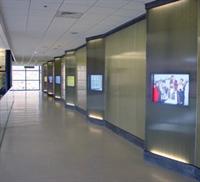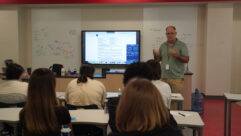

Greening Lessons
The popularity of green building grows more every day, especially in the education vertical market. And AV equipment and design aren’t exempt from participating in a school’s plan to earn LEED-certification for its new facilities.
DIGITAL EXTRAS
THE POPULARITY OF GREEN BUILDING grows more every day, especially in the education vertical market. In April 2007, the U.S. Green Building Council (USGBC) specified that all new-construction K-12 schools seeking Leadership in Energy and Environmental Design (LEED) certification will need to abide by the new LEED for Schools rating system. The rating system is “designed to improve children’s health, productivity, and learning capacity while also helping school buildings to be more energy efficient and resource friendly,” according to USGBC. The effective use of AV equipment and design plays a role in meeting those goals.
Homewood Middle School in Homewood, Ala. — the first middle school in the country to earn LEED-certification (Silver) — was completed in January 2005.
Credit: JOHN O’HAGAN, LEWIS KENNEDY, MARY CATHERINE ANTHONY, GIATTINA FISHER AYCOCK
The LEED rating system is based on credit points, which a school accumulates to earn various degrees of achievement, from Certified to Platinum. Among the sustainability and health-related areas, the system also includes requirements for enhanced acoustical performance and lighting system design and controllability. “LEED-certified schools typically use state-of-the-art technology to maximize on the different principle tenants of the buildings,” says Rachel Gutter, school sector manager for USGBC.
There are two options for acoustical performance achievement depending on the number of credit points desired: For one point, the maximum unoccupied background noise level in a classroom should be 40 dBA; for two points, no more than 35 dBA. Architects often employ acoustical consultants to help them understand how different materials and finishes contribute to or take away from the sound quality in a classroom. The earlier a consultant is included on a project, though, the better. The shape of a room also has tremendous impact on audio quality.
While LEED emphasizes the use of natural light in a building, LEED for Schools considers the light quality of a classroom when presentation equipment is in use in its credit for lighting system design and controllability. Under the requirement, a classroom’s lighting system must function in two modes: general illumination and AV. In AV mode, the design must achieve an average desk-level illumination of 10 to 20 footcandles for any point in the room more than 3 feet from the side walls, 10 feet from the front wall, and 6 feet from the rear wall, with a limited vertical illumination of no more than 7 foot candles at any point on the projection screen. “The idea is not to get as much light into a classroom as possible, but to get the appropriate amount of light into the classroom and provide the necessary controls and mechanisms to make sure it functions for AV as well,” Gutter explains.
The LEED for Schools rating system doesn’t include requirements for energy-efficiency in AV equipment, but having a more efficient product is still an advantage. “LEED awards project teams for holistically looking at light and technology within a classroom and a school and maximizing on efficiency wherever possible,” Gutter says. So, if an integrator wanted to use an energy-intensive HD projector or electronic whiteboard in a classroom, the designer could install more energy-efficient lighting to balance out the energy savings.
The number of LEED-certified schools increases daily. At press time, there are at least 70 schools in the United States that have been certified, and 525 school projects have applied for certification. Because project leaders register their certification intent during the planning stages, there’s no way of knowing how many of those schools are in the building phase or still being designed.
Current structures also have the opportunity to go green with the Clinton Climate Initiative’s new Green Schools Program, which aims to retrofit existing schools across the country to reduce their energy consumption, further increasing the number of potentially green schools.
According to Gutter, the best thing AV professionals can do to market their services to this growing movement is to educate themselves on what it means to be a green school. Manufacturers, in particular, should consider how they can make their products more energy efficient, because that is still the best way to appeal to LEED-focused school planners.
Be careful, though, of hopping on the emerald bandwagon. “Schools are becoming more and more wise to industry-spread instances of ‘green washing,’” says Gutter. “[Manufacturers] shouldn’t hype up what’s green about their product so much as identify ways to increase the potential of their product within the green market by actually making the changes wherever possible.”
Find a LEED School Near You
Clinton Climate Initiative Green Schools Program Partners
Allegheny College
American College and University Presidents Climate Commitment
American Federation of Teachers
Arizona State University
Association of Sustainability in Higher Education
Chicago Public Schools
College of the Atlantic
Council of Educational Facilities Planners International
Dakota County Technical College
EcoAmerica
Earth Day Network
Illinois Association of School Board Members
Kansas Governor Kathleen Sebelius
L.A. Community College District
Miami-Dade County Public Schools
Middlebury College, National Association of School Boards
National Education Association
Ohio School Facilities Commission
Rio Rancho Public Schools, Second Nature
U.S. Green Building Council
University of Colorado at Boulder
University of Idaho
University of Illinois at Chicago
Washington, D.C. Public Schools
January 2007 PRO AV cover story, Pro AV Goes Green
Point and Click
For more information about green schools, please visit,
USGBC Build Green Schools program
http://www.buildgreenschools.org
USGBC
www.usgbc.org
William J. Clinton Foundation
www.clintonfoundation.org










